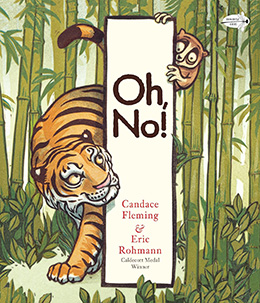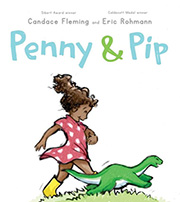BOOKS

illustrated by Eric Rohmann
Schwartz & Wade
September 2012
978–0‑375–84271‑9
ages 3 to 7
buy the book
paperback
e‑book
read & listen app
After you’ve read Oh, No! try this book:
Oh, No!
Young children will delight in repeating the refrain “OH, NO!” as one animal after another falls into a deep, deep hole in this lively read-aloud. Fans of Rohmann’s Caldecott Medal-winning My Friend Rabbit will be thrilled to see a new book created in the same expressive and comical style.
Resources
- Oh, No! Readers Theater
Awards and Honors
- Bull-Bransom Award for illustration, 2011
Reviews
“With text that begs to be read aloud and sumptuous illustrations made by a master printmaker, this picture book reads like an instant classic. Jacket art populated by several animals that appear in the story establishes the Asian jungle setting: A toothsome tiger lurks, while a loris, mouse and frog cower on front and back boards. The palette is rich with shades of brown, green, orange and bluish-gray, and the cover’s scene carries over on to endpapers that show Tiger stalking Frog. The chase continues across front matter pages until the first spread reads: ‘Frog fell into a deep, deep hole. Ribbit-oops! Ribbit-oops!’ Dramatic visual perspective captures Frog’s fall, and the following spread shows Tiger settling in for his next move on his prey. As Tiger waits, a speech balloon heralds the titular cry, ‘Oh, no!’ Clearly, Frog is in trouble, and on ensuing pages, several animals make rescue attempts, only to fall into the hole as well. Finally, a trumpeting, stomping elephant arrives and uses its trunk to save almost all of the trapped animals: Tiger (who had tried to get to the animals with dinner rather than rescue on his mind), falls into the hole on a prior spread, and after the elephant’s valiant rescue, they all cry ‘Oh, no!’ when he cries for help. Oh, yes! This is a terrific new picture book.” (Kirkus Reviews, starred review)
“Rohmann’s relief prints bring an exuberant humor to Fleming’s rhythmic read-aloud. When an elastic-looking frog falls into a deep hole (‘Ribbit-oops!’), a timid mouse, lugubrious loris, resourceful sun bear, and jaunty monkey all tumble down after him during unsuccessful rescue attempts. Fleming’s bouncing rhymes and repeated lines — set in comfortably large, rounded text — entice readers into an enjoyable delivery complete with snarled sound effects and onomatopoeic exclamations. The repetitive ‘Oh, no!’ allows listeners to join in with the engaging text as the animals face a lurking tiger eager to snack on the helpless group. Rohmann knows to leave swathes of open space in his full-spread illustrations, focusing attention on his expressive, energetic animals in their vibrant safari palette of bright browns, tans, and greens. In a satisfying conclusion, the refrain returns as the tiger, now stuck in the hole, asks the released animals if they will help him clamber out. Oh, no!” (School Library Journal, starred review)
“In this first collaboration from Fleming and Rohmann, jungle animals tumble one by one into a deep pit: ‘Frog fell into a deep, deep hole. Ribbit-oops! Ribbit-oops!’ The rhythm of the lines recalls the old favorite ‘Frog Went A‑Courtin’,’ and the story’s chain of accidents and bumbling characters are friendly, familiar devices, too. Mouse falls in trying to rescue Frog, Loris tumbles down from a tree, Sun Bear’s rescue attempt fails, Monkey’s swing from a vine goes wrong, but — just as Tiger looms above — they’re all rescued by a kindly elephant. It sounds like light fare, but Rohmann’s magnificent woodblock-style prints give it unexpected dignity. The jungle pit is as spacious as a cathedral, and the animals somersault into it like Olympic divers in slow motion. Humor prevails, though, with piquant sound words (‘The ground bumble-rumbled and quake-shake-quaked’), speech balloons floating up out of the pit, and glimpses of the tiger’s tail and paws. It’s a book with the feel of an older classic — and it may well become one.” (Publishers Weekly, starred review)
“Chased by a grinning tiger, a wee frog falls down a deep, dark hole. In turn, a mouse, a loris, a bear, and a monkey all swing by to help, but each manages to fall in just the same. Then the tiger, who’s been hiding just offstage, prepares to feast — until an elephant pounds his way onto the scene and turns the tables. Fleming invigorates this simple story with repetitious, rhythmic phrases that sing when read aloud: ‘The ground bumble-rumbled and began to quake. / BA-BOOM! / The ground bumble-rumbled and quake-shake-quaked. / And look who came to help them escape.’ The whole story pretty much takes place inside a hole, but Rohmann cunningly mixes shifting perspectives to liven up every spread, and though the beautifully rendered animals are done via relief printing, the lines are so graceful that they look like casual brushstrokes. Sure to be a hit for boisterous storytime readings. HIGH-DEMAND BACKSTORY: Fleming and Rohmann are both hugely popular in their own rights, and the marquee matchup should generate plenty of attention.” (Booklist)
“For her cumulative tale about animals falling into a hole, Fleming adopts the dancing cadence of ‘Frog Went a‑Courting,’ punctuates each verse with a chime-in phrase, and concludes it with a repeated ‘Oh, No!’: ‘Frog fell into a deep, deep hole. / Ribbit-oops! Ribbit-oops! … Frog fell into such a deep hole, / he couldn’t get out to save his soul. / Croaked Frog, ‘Help! Help! I can’t get out!’ / Oh, No!’ So it goes with Mouse, Loris, and more, until Tiger — who’s been lurking nearby all along — threatens to ‘help [them] out.’ Fortunately, Elephant shows up to save the others while Tiger falls into his own trap — at least until the escapees are safely out of sight. Rohmann’s energetic relief prints show the animals’ tumbles into that deep, dark, curvilinear hole from a variety of perspectives, further propelling the comic action, while a simply delineated bamboo grove forms an effective backdrop. Like Rohmann’s 2003 Caldecott winner My Friend Rabbit, this has all the marks of a soon-to-be-memorized favorite.” (The Horn Book)


